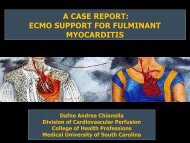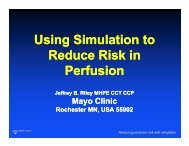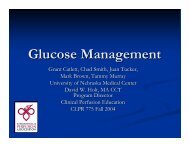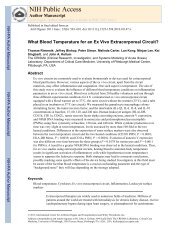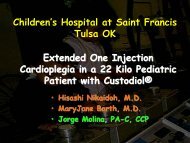PowerPoint Presentation (PDF) - Perfusion.com
PowerPoint Presentation (PDF) - Perfusion.com
PowerPoint Presentation (PDF) - Perfusion.com
Create successful ePaper yourself
Turn your PDF publications into a flip-book with our unique Google optimized e-Paper software.
Emergency Department Use of<br />
Thromboelastography in Trauma: “Goal<br />
Directed” Blood Component Therapy<br />
and Beyond<br />
Mark Walsh MD FACEP<br />
Indiana School of Medicine<br />
Notre Dame Campus, South Bend, Indiana
Notre Dame Study of<br />
Thromboelastographic Decisions Group<br />
Mark Walsh MD,<br />
Scott Thomas MD<br />
Frank Castellino PhD<br />
Deborah Donahue BS<br />
Rudy Navari MD PhD<br />
Ed Evans BA CCP<br />
Andrew Medvecz BS
Objectives<br />
• 1. Acute Traumatic Coagulopathy<br />
• 2. TEG-PM in the Emergency Department (ED)<br />
for “goal directed” BCT. “Art=Science”<br />
• 3. Other indications for ED use of the TEG<br />
• 4. Central importance of the perfusionist for<br />
the implementation of TEG guided goal<br />
directed BCT in the ED.
The generation or exposure of<br />
TF at the wound site, and its<br />
interaction with factor VII, is the<br />
PRIMARY physiologic event<br />
in initiating clotting. The<br />
<strong>com</strong>ponents of the intrinsic<br />
pathway (ie, factors VIII, IX, XI)<br />
are responsible for<br />
AMPLIFICATION of this<br />
process only after a small initial<br />
amount of thrombin has been<br />
generated through the extrinsic<br />
pathway.
Tissue factor (TF)<br />
is exposed and<br />
binds to FVIIa or<br />
FVII which is<br />
subsequently<br />
converted to<br />
FVIIa<br />
FXa binds to FVa<br />
on the cell surface<br />
The <strong>com</strong>plex between<br />
TF and FVIIa activates<br />
FIX and FX<br />
Trauma,<br />
induces the initiation<br />
of coagulation<br />
Hemostasis: Initiation Phase TF-VIIa=R
The FXa/FVa <strong>com</strong>plex converts<br />
small amounts of prothrombin<br />
into thrombin<br />
FXIa converts FIX to FIXa<br />
The small amount of<br />
thrombin generated<br />
activates FVIII, FV, FXI<br />
and platelets locally.<br />
Activated<br />
platelets<br />
bind FVa,<br />
FVIIIa<br />
and FIXa<br />
Hemostasis: Amplification phase small Th =K
The FVIIIa/FIXa<br />
Complex activates<br />
FX on the surfaces of<br />
activated platelets<br />
The “thrombin<br />
burst” leads to the<br />
formation of a<br />
stable fibrin clot.<br />
FXa in association with FVa converts large amounts of<br />
prothrombin into thrombin creating a “thrombin burst”.<br />
Hemostasis : Propagation Phase TH Burst=alpha
Thrombin binds<br />
Thrombomodulin<br />
The <strong>com</strong>plex<br />
Thrombin-<br />
Thrombomodulin<br />
activates Protein C<br />
APC decreases<br />
FVIIIa and FVa<br />
and induces<br />
D-dimers production<br />
Activated protein C pathway
700 Patients Reviewed 2009<br />
Injury Severity Score and TEG
ISS minor 10-20;20-35;>30
J Trauma. 2007;62:307–310.
“Damage Control Resuscitation”<br />
• Rapid recognition of “trauma-induced<br />
coagulopathy” (massive transfusion prediction)<br />
• Permissive hypotension/minimizing use of<br />
crystalloids<br />
• Early transfusion of RBC:FFP:PLTs in a 1:1:1 ratio<br />
• Appropriate use of rFVIIa and fibrinogen containing<br />
products such as cryoprecipitate<br />
• When available, POC coagulation assays such as<br />
rapid thromboelastography (rTEG) to guide<br />
administration of blood products.
Strategies for Blood Component<br />
Resuscitation in the ED<br />
• Massive Transfusion Protocol (MTP)<br />
definition >10uPRBC/24hr (now 6 hours<br />
Kashuk and Moore)<br />
• 1PRBC:1FFP:1PLTS “DCR”<br />
–1:1:1 we use 6:6:6 plus immediate<br />
calcium<br />
–Never seen a normal calcium in MTP<br />
case<br />
–Multiple Trauma can be a “Living Hell”
The generation or exposure of<br />
TF at the wound site, and its<br />
interaction with factor VII, is the<br />
PRIMARY physiologic event<br />
in initiating clotting. The<br />
<strong>com</strong>ponents of the intrinsic<br />
pathway (ie, factors VIII, IX, XI)<br />
are responsible for<br />
AMPLIFICATION of this<br />
process only after a small initial<br />
amount of thrombin has been<br />
generated through the extrinsic<br />
pathway.
Massive Transfusion in “Chest”<br />
2009;136:1654-1667<br />
Siler and Napolitano<br />
• p1658 “ Randomized controlled trials of how<br />
to best to administer coagulation factors (FFP,<br />
platelets and cryoprecipitates) in the presence<br />
of ongoing severe traumatic hemorrhage are<br />
difficult to execute and have not been<br />
published”……..”most MTP grossly<br />
underestimate the treatment that is needed<br />
to correct the coagulopathy”
Solution to Blind Adherence to 1:1:1<br />
– “triggers” for MTP ?<br />
–Dr. Thurer: “operative bleeding” =<br />
“trigger”<br />
–Pre hospital and ED bleeding<br />
“triggers<br />
–“triggers and TEGs”
Triggers for MTP
TASH<br />
• Trauma Associated Severe Hemorrhage<br />
• A simple scoring system to predict the need<br />
for massive blood transfusion in severe<br />
trauma patients<br />
• An analysis from the German Trauma<br />
Registry 1993-2006<br />
• 29,353 patients 125 hospitals<br />
• 6044 patients <strong>com</strong>plete data 13.9% MTP<br />
• 4427 patient data set
ABC<br />
• Penetrating mechanism (0 = no, 1 = yes)<br />
• ED SBP of 90 mm Hg or less (0 = no, 1 = yes)<br />
• ED HR of 120 bpm or greater (0 = no, 1 = yes)<br />
• Positive FAST (0 = no, 1 = yes)<br />
2009; 66: 346-352
20 year old motorcycle crash<br />
• Transferred from another facility.<br />
• Spleen and kidney are ruptured with much<br />
intraperitoneal blood.<br />
• Bowel and mesenteric lacerations as well.<br />
• Received 4 liters LR and 2uPRBC prior to<br />
arrival.<br />
• Hypotenisve, tachycardic, no base deficit.
ABC criteria for MTP<br />
• Hypotensive……………………………………………1<br />
• Tachycardic…………………………………………….1<br />
• Blood in CT scan of abdomen………………….1<br />
• Not penetrating………………………………………0<br />
• 3 out of 4 therefore MTP is triggered.
ABC + TASH Criteria are “fluid” in ED<br />
• Male………………………………………………………….1<br />
• Hypotensive120……………………………………….2<br />
• Free Fluid US or CT……………………………………3<br />
• 1+3+2+4=10 initial likelihood of MTP …….20%.<br />
• One hour later BD= -6 for 3 extra points<br />
• One hour later Hb= 8 for 7 extra points<br />
• 10+10=20. >65% chance needing MTP<br />
• <strong>Perfusion</strong>ist runs ISTAT “GC8” with TEG-PM
TEG normal in ED
ADP in ED
AA in ED no NSAID History
ADP post platelet transfusion in OR
AA post platelet transfusion in ER/OR: Total 8 uPRBC,<br />
2uFFP, 2SD plts TEG-PM driven not by blind 1:1:1
TEG post op day 1: DVT prophylaxis
TEG “Goal-Directed” BCT<br />
TEG<br />
abnormality<br />
Prolonged<br />
R<br />
Prolonged k and/or Low MA<br />
reduced alpha angle<br />
Elevated LY30%<br />
BCT FFP<br />
CRYOPPT plts<br />
DDAVP<br />
Address hypothermia,<br />
acidosis, hemorrhage,<br />
dilution, low Calcium.<br />
Consider rFVIIa,<br />
thrombocytopathy<br />
and antifibrinolytics.
36 year old in hemorrhagic shock<br />
• Peutz Jeghers duodenal tumor biopsy site<br />
• Immediate MTP activation<br />
• Requires 6 PRBC/6FFP/”6u”plts units in ED<br />
• IR coiling duodenal vessels after failed clipping<br />
• On Day 2 after 10 units PRBC, 6 units FFP and<br />
2 SD apheresis platelets resumes bleeding and<br />
thrombocytopenic. IF OR = Whipple<br />
• TEG normal but platelet mapping is not
Peutz Jeghers Syndrome Whipple?
35 year old female in shock in ED<br />
rTEG in ED
TEG in ED
ICU AM day 2 plts 54K 2SD plts
ADP ICU in AM DAY 2
AA in ICU AM day 2
TEG in ICU PM day 2 re-bleeding at plts<br />
count 104K low BP Hb 8.6
ADP ICU PM day 2 after 2 more SD plts<br />
given at 54K now 104K
AA in ICU PM day 2 after 2 more SD<br />
plts given at 54K now 104K
TEG ICU AM day 3 after 4 SD platelets since<br />
54k. No bleeding after clip and 2 nd coiling<br />
6uPRBC no more FFP plts=134K
ADP in ICU AM day 3 no bleeding.
AA ICU AM day 3 no bleeding
TEG on floor day 4 stable
ADP on Floor day 4
AA on floor day 4<br />
Final Tally 16uPRBC, 6uFFP, 5SD plts no<br />
cryoppt
Platelet function testing has not been<br />
well studied in trauma<br />
• Brohi on platelet dysfunction in ATC Current<br />
Opinion in Anaesthesiology 2009;22:261–266<br />
“only one study has evaluated platelet<br />
function and activation in injured patients.”<br />
• Elderly patients and patients on platelet<br />
inhibitors not un<strong>com</strong>mon
Peutz Jeghers Whipple?
Ejection fraction 11 %
Peutz Jegher’s Mom and child
Indications for the Use of TEG in the<br />
ED<br />
Suggested Indications for TEG analysis in Trauma Population<br />
1. Massive transfusion<br />
2. Traumatic and non traumatic brain injury with bleeding<br />
3. Unexplained continued surgical bleeding<br />
4. Suspected platelet dysfunction<br />
5. Re<strong>com</strong>binant Factor VIIa use<br />
6. Potential organ donor with coagulopathy<br />
7. Early cessation of resuscitation in severe trauma with<br />
poor prognosis due to <strong>com</strong>orbidity<br />
8. Identification of hypercoagulable patient
TEG is not business<br />
It’s Personal
The Future of Emergency Department<br />
TEG?
Action of rFVIIa
Potential Role of FVIIa in<br />
Acute Traumatic Coagulopathy<br />
Direct thrombin generation even in the<br />
absence of FVIII and FIX<br />
Increase Xa<br />
Direct activate IX on activated platelet<br />
FVIIa<br />
Inhibit<br />
Fibrinolysis



